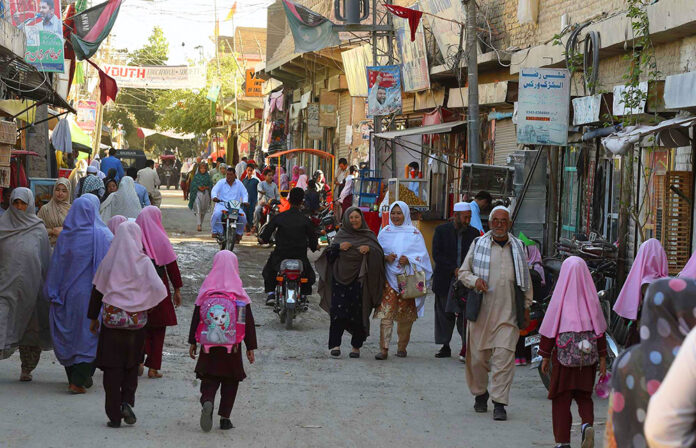Poverty extends beyond limited financial resources and an inability to meet basic needs; it also includes restricted access to social services, assets, and political representation. While income is a common measure of poverty, it is not always the most comprehensive. Modern development economics emphasizes asset-based policies that focus on savings, investments, and wealth accumulation. These strategies promote personal growth and skill enhancement, aiming to foster financial independence and more effectively alleviate poverty by prioritizing long-term financial stability.
Poverty, a global societal issue and economic challenge, is a significant issue in Pakistan, with 39.4 percent of the population living below the poverty line (World Bank-2023), a persistent issue spanning socioeconomic and regional divides, highlighting the country’s profound implications for its citizens. Pakistan faces significant challenges in poverty reduction compared to its South Asian neighbours, such as India and Bangladesh. India has seen a significant decrease in poverty from 21.9 percent in 2011 to 13.4 percent in 2020, while Bangladesh has seen a decrease from 31.5 percent in 2010 to 24.3 percent in 2021. Pakistan’s poverty rate has shown less dramatic improvement during 2018-2023 due to political instability, governance issues, and regional disparities.
Balochistan, the largest province of Pakistan with 44 percent of the total area, is characterized by severe poverty and underdevelopment, with 71 percent of its population living below the poverty line. The region’s geographical isolation, inadequate infrastructure, and socio-political unrest contribute to the cycle of poverty, making it challenging for residents to break free from systemic disadvantage. As per recent studies conducted by both government and donor agencies, Balochistan remains the most impoverished province in Pakistan, accounting for approximately 12-14 percent of the country’s total poor population. This persistent disparity highlights a pressing need for targeted interventions to address the challenges faced by this region. Three studies highlight this poverty: the Pakistan Institute of Development Economics estimates that nearly 51 percent of households in Balochistan live below the income poverty line, accounting for 12 percent of the total poor households in the country; the Pakistan Multidimensional Poverty Index Report 2022, which shows that 71 percent of Balochistan’s population lives in multidimensional poverty, accounting for 14 percent of Pakistan’s total multidimensionally poor population; and the Pakistan National Human Development Report 2020 on Inequality, produced by the UNDP, which shows that Balochistan is over-proportionately represented among the poorest 20 percent compared to the province’s share in the overall national population distribution.
The Balochistan government’s five-year initiative, launched in 2022, aims to address critical areas including water security, energy sufficiency, infrastructure, connectivity, and agricultural development. However, major cities like Quetta and Gwadar face significant challenges, with projects such as the Mangi and Halak dams delayed due to issues with power sources and funding. A key factor in Balochistan’s underdevelopment is its low urbanization rate, with only 14.38 percent of the population living in urban areas. The largest cities, including Khuzdar, Turbat, Quetta, and Chaman, have not expanded sufficiently to meet the needs of their populations. This limited urban growth, combined with the province’s small and dispersed population, challenging geography, and high service delivery costs, impedes overall economic development. Balochistan is rich in natural resources such as mineral deposits and extensive rangelands. Despite this capital, the province struggles with low household incomes, limited industrial activity, and scarce employment opportunities. Though 70 percent of approved uplift schemes have been allocated through the Provincial PSDP for various projects, progress remains slow due to numerous constraints.
Balochistan faces challenges with limited renewable sources and unreliable access. Establishing isolated energy grids for local production, connecting Balochistan to the national grid, and upgrading energy transmission infrastructure are crucial steps for addressing the province’s energy needs. Equally important is the improvement of road infrastructure, which is essential due to the province’s challenging terrain and nomadic lifestyle. A thorough road survey, effective tolling mechanisms, and enhanced digital connectivity are needed to support sectors such as tourism, handicrafts, tele-education, and telemedicine.
Ensuring law and order through effective law enforcement, counter-insurgency strategies, and community engagement is essential for creating a stable environment conducive to economic activity. By addressing political instability, regional disparities, and implementing sustainable solutions, Balochistan can work towards a more prosperous and equitable future for all its residents.
With insurgent activities frequently targeting and damaging critical infrastructures, a robust security plan must be implemented. This plan should encompass increased surveillance, secure construction practices, and coordination with local communities to enhance vigilance and reporting of suspicious activities. Engaging with local stakeholders and fostering community support will also be crucial for protecting and maintaining these infrastructure investments.
Air connectivity is another area of concern, with limited flights currently available. Upgrading and operationalizing airports in Balochistan, including those in Quetta, Gwadar, Pasni, Panjgur, Dalbandin, Ormara, Khuzdar, Sui, and Turbat, while ensuring affordable prices and regular flights from various airlines, is essential for enhancing access and connectivity.
Balochistan also has substantial potential for agricultural development, especially in its arid regions. Expanding arable land, adopting drought-resistant farming techniques, and providing incentives such as crop buying guarantees and easy land leases can boost agricultural output and create jobs. Both federal and provincial governments need to effectively play their roles, fund strategic projects, streamline development processes, and collaborate on a comprehensive Integrated Balochistan Governance and Development Strategy to address Balochistan isolation and public discontent. This approach will unlock the province’s economic potential and mitigate the impacts of underdeveloped urban areas. Improving social protection through increased income support, food assistance, and healthcare subsidies is crucial for alleviating the financial pressures on vulnerable populations.
Specifically, safety net programs such as Benazir Income Support Programme (BISP) and Pakistan Bait-ul-Mal (PBM) should expand their coverage to reach more people, given the high levels of poverty in the province.
Ensuring law and order through effective law enforcement, counter-insurgency strategies, and community engagement is essential for creating a stable environment conducive to economic activity. By addressing political instability, regional disparities, and implementing sustainable solutions, Balochistan can work towards a more prosperous and equitable future for all its residents.























